Les tests ont été réalisés dans un ciel bien pollué par l'éclairage artificiel et le solstice, avec soit
un Newton 254, soit un téléobjectif de 180mm de focale ouvert à f/2,3, sans aucun filtre
à l'exception d'une image en H-alpha. Après des séries de tests, suivant les conseils
de ZWO et en accord avec les autres testeurs, il s'est avéré que le meilleur
moyen de photographier le ciel profond avec cette caméra planétaire était d'accumuler
un très grand nombre de poses très courtes à gain faible ou nul (le gain à 76/600
correspond à un gain de 1; un gain de 200 montre très peu de bruit, et la marge reste
considérable puisque le gain va donc jusqu'à 600, soit 72 dB !).
|
The tests were performed under a light-polluted
suburban sky in summer soltice with either a 254-mm (10-in) Newton
or a 180-mm f/2.3 telelens,
with no filter at the exception of an image in H-alpha. After series
of tests, in accordance with ZWO's advices and the experience of the
other beta testers, the best way to perform deep-sky imaging with
this planetary camera proved to be recording a huge number of very short exposures
and no or little gain (76/600 is unity gain, 200 shows very little
noise, but the margin remains huge with a max gain of 600 = 72 dB !). |
|
La température du capteur est montée jusqu'à 25°C environ en juillet. Je n'ai pas installé
le refroidissement (bricolage sur l'ASI120MM) afin de tester la caméra brute. Toutefois
une version refroidie par Peltier avec régulation était déjà prévue pour les mois
à venir.
Le driver prototype de la caméra a été livré avec quelques problèmes
à l'origine: la gestion du mode 12 bits et le décodage de la matrice de
Bayer; ce dernier a été résolu temporairement avec un décodage
par PIPP et une calibration manuelle. En août 2015, tous les
problèmes étaient résolus et la caméra est devenue pleinement
opérationnelle.
|
The sensor temperature was up to 25°C on July. I decided to use the
camera with no cooling (the DIY one from the ASI120MM). However the
ASI224MC was planned to be provided with a real regulated, Peltier
cooling some months later.
The prototype camera driver was delivered with some initial issues:
12-bit management and Bayer decoding had some trouble, fixed with PIPP
for debayering and manual correction. As of August 2015, all the issues
were fixed and the camera was eventually fully operational.
|
|
L'avancée marquante est que cette caméra peut fonctionner de différentes manières:
- Imagerie planétaire avec une telle sensibilité, si peu de bruit et
une telle facilité d'utilisation qu'après avoir pratiqué avec ferveur l'imagerie RGB pendant
10 années, elle m'a convaincu que les caméras planétaires monochromes utilisées avec
WinJupOs (qui est remarquable) et une roue à filtres appartenaient désormais au passé. Je n'ai
pas pu photographier les planètes à la date des tests, mais j'ai sérieusement testé l'ASI120MM en planétaire et en
ciel profond or l'ASI224MC est meilleure en tout, sauf en résolution à cause de la couleur,
mais cela peut être compensé en augmentant le taux d'échantillonnage en augmentant le gain,
tout cela avec moins de bruit.
- La bande passante est assez étendue pour la photo en bande étroite dans l'intégralité
du spectre habituel. Marc Delcroix a photographié Saturne avec d'excellents résultats dans
la bande du méthane et Uranus dans l'infrarouge proche (>685 nm). Le niveau de
résultat était comparable à des caméras monochromes de haut de gamme à bande élargie dans le
proche infrarouge.
- De plus, j'ai photographié le Triangle de Pickering (découvert en fait par
Williamina Fleming mais, comme d'habitude, c'est son directeur d'observatoire qui en a
été crédité) en bande étroite avec un filtre hydrogène alpha de 6nm. Les résultats
préliminaires ont montré qu'un éventuel refroidissement apporterait un avantage
limité car le bruit total reste faible (pixels chauds, offset, bruit thermique
éclairant le coin en haut à droite de l'image). Bien entendu, les longues poses
ne sont vraiment pas la meilleure utilisation de cette caméra, mais ça marche.
- Ce n'est pas tout: malgré un seuil de détection équivalent plutôt élevé, de
nombreux objets du ciel profond sont aisément accessibles pourvu qu'ils soient
suffisamment contrastés. Le but n'est pas de tenter de concurrencer une caméra CCD
mais la capacité à éviter la turbulence atmosphérique avec des poses très courtes
et un bruit extrêmement bas rendent possibles les images du ciel profond
avec les techniques de l'imagerie planétaire. Autrement dit, cette
caméra permet la photographie du ciel profond à haute résolution. Seule une
caméra EMCCD en était capable jusqu'alors, mais pour 25 000 euros de plus...
|
The breakthrough is that this camera can successfully operate in different ways:
- planetary imaging with such a sensitivity, low noise and incredible
ease-of-use that it convinced me, after 10 years of fanatical RGB imaging, that
monochrome planetary cameras with the (unvaluable) WinJupOs and filters
wheels belong to the past from now on (for amateur, leisure imaging). I could not
shoot planets at this date (others did), but I have seriously exploited the ASI120MM
in both planetary and deep-sky imaging, and the 224 is better in all aspects,
at the exception of accuracy because of the Bayer matrix: nonetheless this may
be compensated for with the help of a stronger sampling ratio, more gain and less noise.
- the sensitivity in the whole spectrum is very good. Saturn
has been imaged with excellent results in methane (CH4) band and
Uranus was shot in near infrared (>685nm) by Marc Delcroix.
The images show the same quality as cutting-edge monochrome,
NIR-depleted cameras.
- Moreover, I shot Pickering's Triangle (discovered by Williamina
Fleming but his director was granted for, as usual.) in narrow band with a 6-nm bandwidth,
hydrogen alpha filter. The preliminary result showed that cooling should be a
limited asset for long exposures because the overall noise (hot pixels, offset
and thermal noise on the upper-right corner) remain low. Of course, long exposures
are not the best use of the camera, but this works.
- In addition, despite the ASI24MC show the equivalent of a too-high
detectivity threshold level, numerous deep-sky objects are easily accessible
as long as they are contrasted enough. The purpose is not to compete CCD cameras
but the ability to beat the turbulence with very short exposures and no
noise leads to perform deep-sky imaging with the same techniques as
planetary imaging. In other words, this camera allows high-resolution
imaging of deep-sky objects.
|
|
Pour conclure, l'ASI224MC est vraiment une caméra polyvalente: d'un coût
abordable, sans nécessiter de refroidissement, la meilleure de toutes les
caméras planétaires en septembre 2015 peut aussi être exploitée selon les circonstances
en monochrome ou en couleurs, en 8 ou 12 bits, en infrarouge proche ou en
imagerie à bande étroite, à haute résolution en ciel profond sur les
objets contrastés ainsi qu'en ciel profond en bande étroite en longue pose,
même sans refroidissement. Elle n'est probablement pas adaptée à la photo
des nébuleuses diffuses étendues ni aux galaxies faibles; cependant les conditions
météo médiocres n'ont pas permis de réaliser des essais en profondeur sur
ces sujets.
|
To conclude, the ASI224MC is a really all-purpose equipment: affordable,
no mandatory cooling, the very best planetary camera as of September 2015
may be exploited in monochrome or colour, 8 or 12 bits, NIR and
narrow-band imaging, high-resolution deep-sky imaging on contrasted objects
and narrow-band, deep-sky imaging with long exposures,
even with no cooling. It is likely not suited to large, faint nebulae or poorly
contrasted galaxies but the bad imaging conditions during summer 2015 did not
allow to perform deep-sky imaging in depth.
|
|
Pour la comparer à ses concurrentes commercialisées par ZWO au même moment, en
termes simples et d'après les données constructeur de Sony:
- L'ASI185MC est la même que l'ASI224MC avec environ deux fois plus de
photosites (pas négligeable !), un peu plus de bruit (3,5x plus)
et moins de gain (voir les données détaillées dans la page sur les caméras planétaires).
- L'ASI178MC a environ deux fois plus de bruit que l'ASI224MC (ce qui reste très faible)
et un gain bien plus faible, mais elle possède un convertisseur 14 bits, 6 mégapixels
(saperlipopette) et un plus grand puits de potentiel (grande dynamique). Au premier
coup d'oeil, l'ASI178MC devrait être mieux adaptée aux amas ouverts étendus, aux
éclipses lunaires et autres sujets à grand champ. D'un autre côté, même si les photosites
de l'ASI178MC sont extrêmement petits, ce capteur est de type BSI et le fill factor (surface
utile des photosites) est bien plus avantageux; donc cette caméra pourrait se révéler
douée en imagerie du ciel profond à large champ, pour une fraction du
prix d'une caméra CCD refroidie plus performante.
|
To be compared to its contemporary competitors from ZWO, in simple words
and according to Sony's datasheet:
- the ASI185MC is the same as the ASI224MC with about twofold photosites
(not to be neglected !), a little more noise (3.5x more) and less gain
(see the page about planetary cameras).
- the ASI178MC has about to times more noise than the ASI224MC (this remains
very low) and a lesser gain, but it offers a 14-bit converter, 6 mega pixels (wow) and
a large potential well (better dynamic).
At a first glance, the ASI178MC should be more suited to large stellar clusters, lunar eclipses
and other wide-field subjects. On the other hand, the 178's photosites are very
tiny but, as the sensor is backside illuminated and because this leads the photosites
to have a better fill factor, the camera could be very interesting for large field,
deep sky imaging at a fraction of the cost of a more performing, cooled CCD camera.
|
|
Livrée avec:
- objectif grand-angle 2,1mm (environ 150°) à monture C, de très bonne qualité
- câble ST4 pour l'autoguidage
- câble USB-3 d'excellente qualité
- adaptateur 31,75
- pas de vis 42mm
- adaptateur C
- CD avec driver et logiciel
- Mode d'emploi en Anglais
Fenêtre de protection neutre (démontable)
L'arrière présente quatre pas de vis M4 et un pas Kodak
|
Delivered with:
- wide-field (about 150°), very good quality objective lens, with a C mount
- ST4 cable for autoguider port
- "premium" USB-3 cable (very thick and stiff, it's all good!)
- 1'1/4 adapter
- 42mm thread
- CD with driver and user's manual
- clear protection window (removable)
- the rear side has four M4 threads and a Kodak thread.
|
|
Images de test ciel profond
Images prises en plein solstice d'été, ciel éclairé de banlieue, magnitude visuelle au zénith typique = 3,5
(pas terrible comme ciel... On a de belles caméras mais on ne peut pas vraiment s'en servir !). Certaines
images sont en plein format dans la page "nébuleuses planétaires" et "amas stellaires". |
Test images ASI224MC deep-sky
Images taken close to the summer solstice, light-polluted, suburban sky, visual magnitude
at zenith is typically 3.5. Some full-format images are shown in the "planetary nebulae" and
"stellar clusters" pages. |
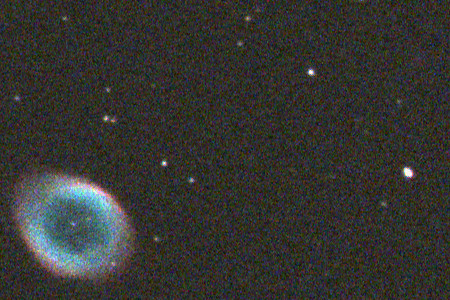 | M57 Newton 254, gain=400, single 5-second exposure. Really astonishing for such a short exposure. |
 | M57 Newton 254, gain=200, single one-minute exposure. |
 | M57 Newton 254, gain=400, 114 x 5 seconds. |
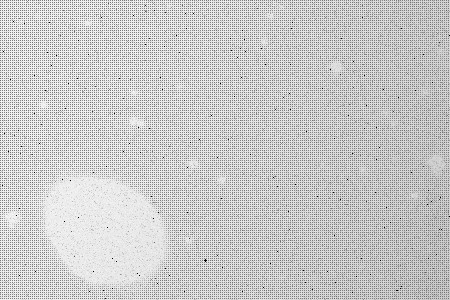 | M57 Newton 254, gain=200, single, raw (no debayering) 5-minute exposure, totally overexposed. |
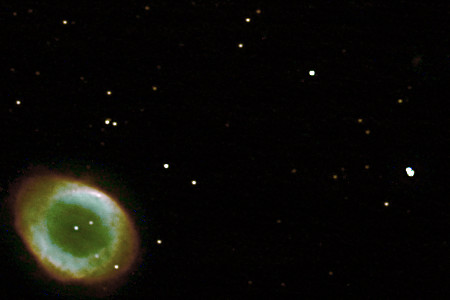 | M57 Newton 254, gain=76, 191 x 5 seconds, 12 bits. Improper colour balance, fixed now with new driver.
Note the details despite the "long" individual exposures. |
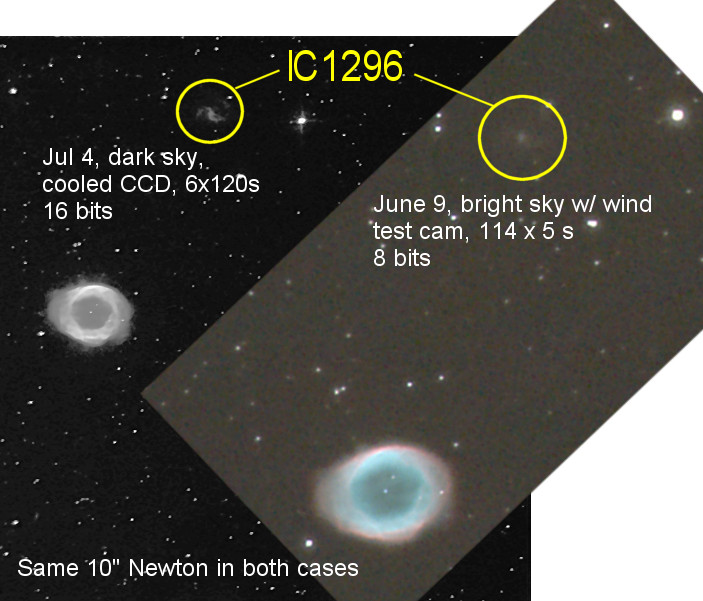 | Comparison of detectivity relative to QHYCCD's QHY6 cooled CCD; note the faint IC1296 spiral galaxy. |
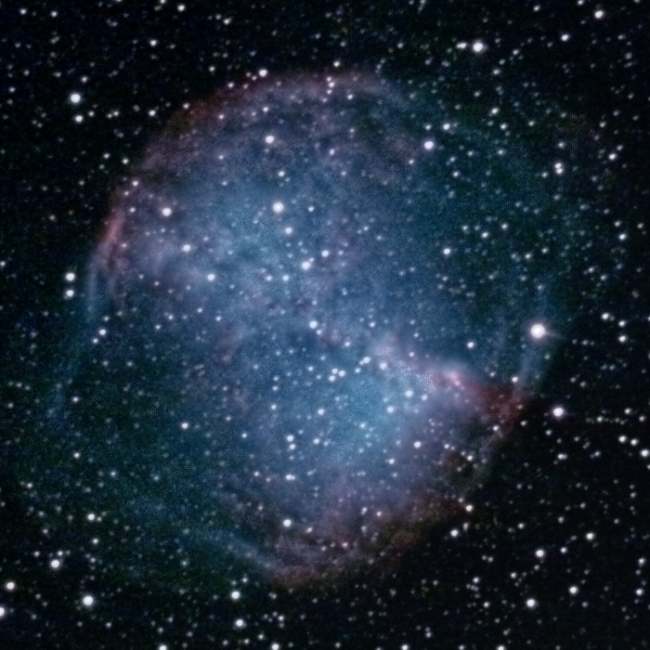 | M27 Newton 254, gain=76, 409 x 5 seconds, 12 bits. |
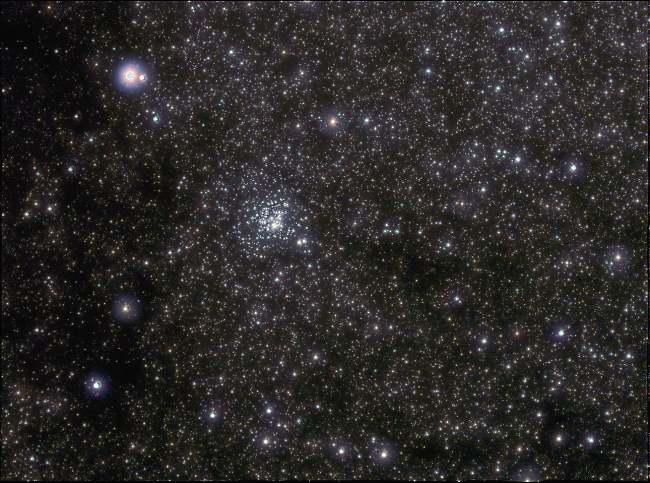 | M11 telelens (180-mm f/2.3), 100 x 10 seconds, 8 bits |
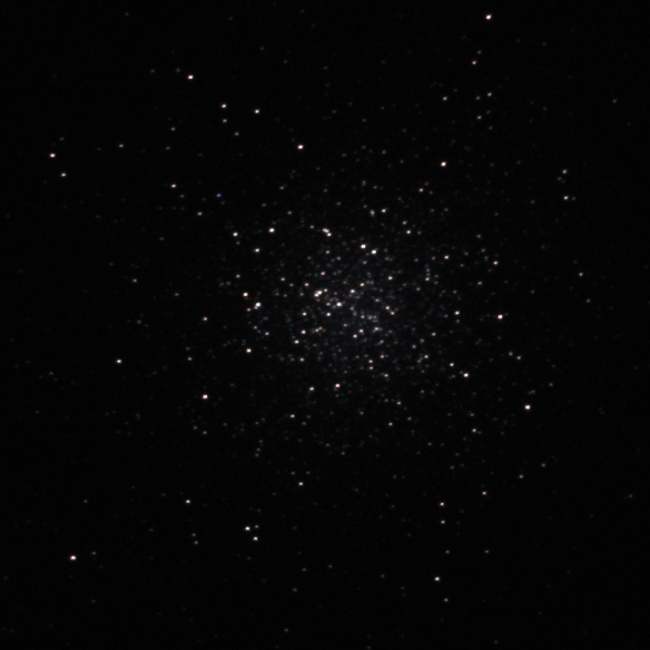 | M13 Newton 254, gain 200, single 5-second exposure, 8 bits |
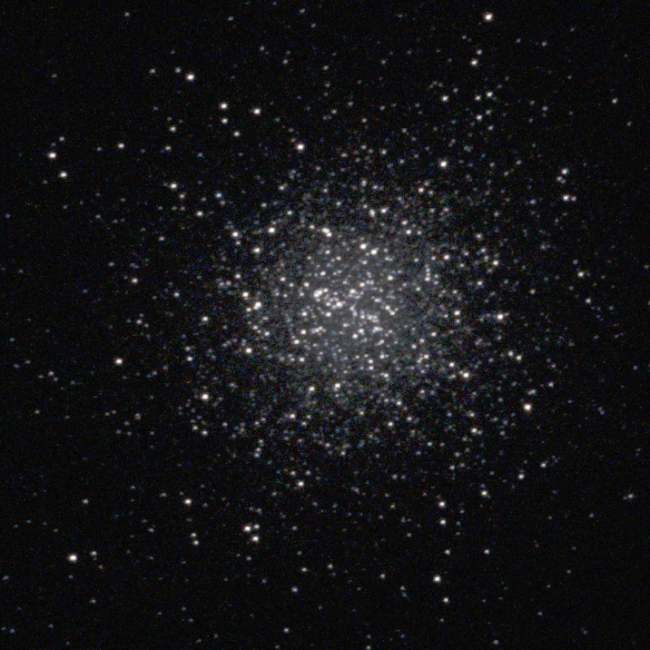 | Same image, levels increased |
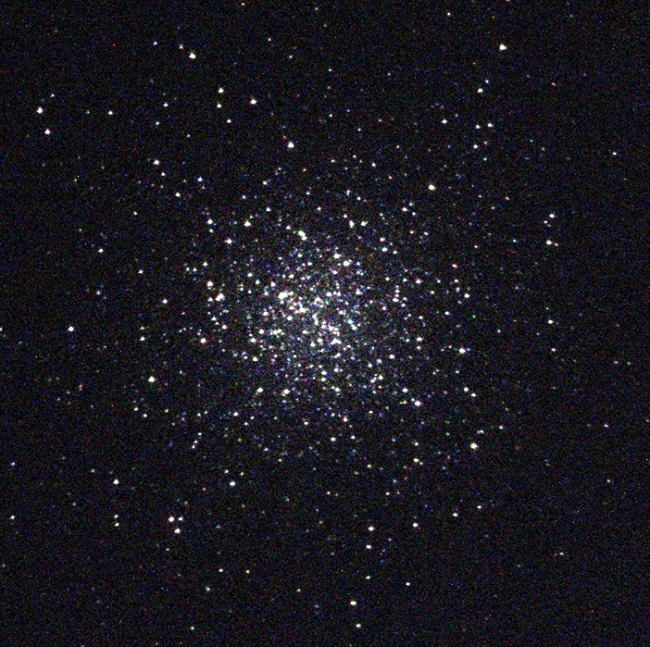 | M13 Newton 254, gain 500, single 500 milliseconds exposure (wahoo), 8 bits.
Noise is conspicious with gain=5/6, but this is
genuine, real-time, colour deep-sky imaging... |
 | M13 Newton 254, gain 250, 135 x 2 seconds, 8 bits, no autoguiding |
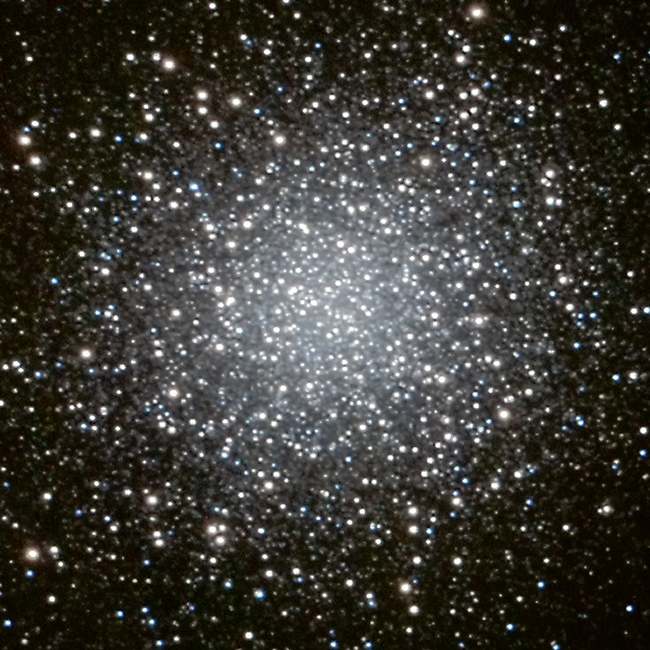 | M13 Newton 254, 350 x 10-second exposures, 8 bits.
Note the loss in accuracy because of the turbulence (and rough processing).
The best method is definitively acquiring numerous, short exposures with limited gain. |
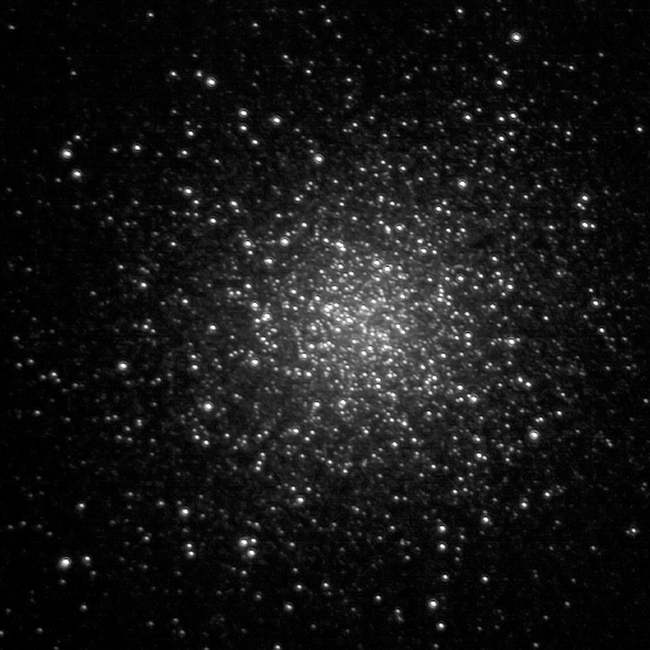 | comparison with QHYCCD's QHY5, 200 x 2.5 seconds, 10 bits |
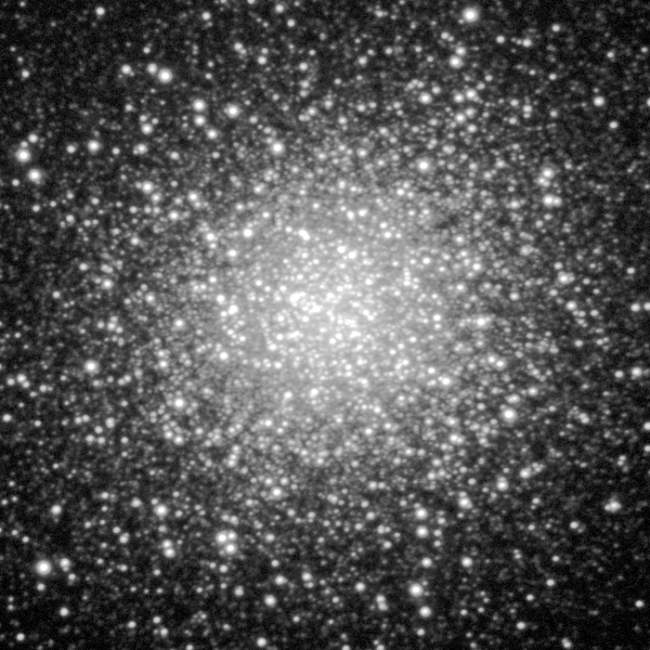 | comparison with ASI120MM, gain 60, 130 x 10 seconds, 10 bits |
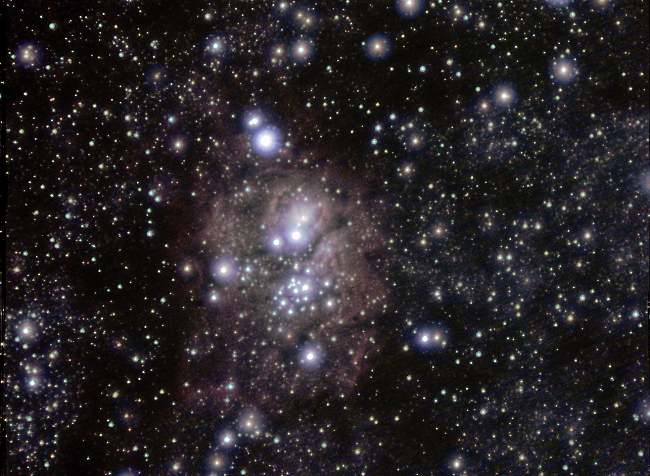 | M8 low above the horizon and mist, telelens, 150 x 10 seconds, 8 bits |
 | Pickering's Triangle (that is Fleming's Triangle), close to dawn, 24 x 2 minutes, 6-nm bandpass, H-alpha filter, telelens, no cooling, 8 bits |




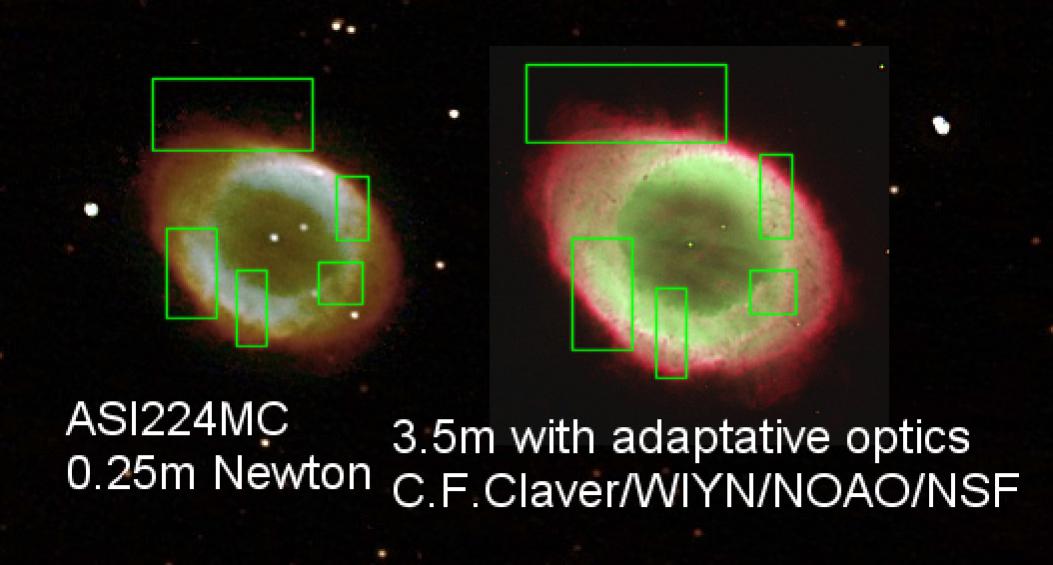

















 up
up